Meal prepping for weight loss is all the rage, but what is it, exactly?
Meal prepping, the practice of preparing and portioning meals in advance, offers a multitude of benefits that can positively impact various aspects of one’s life.
What is Meal Prep for Weight Loss?
It’s important to remember that meal prepping isn’t a sure way to lose weight. However, for the reasons listed, the habit of meal prepping could create other positive habits.
Let’s get the skinny on meal prepping including the potential benefits.
the benefits of meal prepping
So you’re here to learn why meal prepping is all the rage, right?
Here are some of the benefits of meal prepping.
Saves Time:
Meal prepping allows you to dedicate a specific block of time, usually once or twice a week, to prepare meals in advance. This upfront investment of time can save you significant time throughout the week, as you won’t need to cook individual meals each day.
Saves Money:
By planning and preparing your meals in advance, you can reduce the temptation to dine out or order takeout, which can be more expensive than homemade meals. Additionally, buying ingredients in bulk and preparing meals in larger quantities can help lower overall grocery costs.
Promotes Healthier Eating Habits:
Meal prepping empowers you to make intentional and nutritious food choices. When you have healthy, pre-prepared meals readily available, you’re less likely to reach for unhealthy convenience foods or indulge in impulsive eating decisions.
Portion Control:
By pre-portioning your meals during the meal prep process, you can better control portion sizes and prevent overeating. This can be particularly beneficial for those looking to manage their weight or adhere to specific dietary guidelines.
Reduces Stress:
Knowing that you have meals prepared and ready to go can alleviate stress and anxiety associated with mealtime decisions. You can enjoy peace of mind knowing that you have nutritious options available, even during busy or hectic days.
Increases Variety:
Meal prepping allows you to incorporate a diverse range of ingredients and recipes into your weekly menu. You can experiment with new flavors and cuisines, ensuring that your meals remain exciting and enjoyable.
Supports Fitness Goals:
For individuals with fitness or performance-related goals, meal prepping can be a valuable tool for fueling workouts and supporting recovery. By pre-planning meals that align with your nutritional needs, you can optimize your performance and progress towards your goals.
Reduces Food Waste:
Planning and portioning meals in advance can help minimize food waste by ensuring that ingredients are used efficiently and leftovers are utilized. This not only saves money but also promotes environmental sustainability.
Promotes Consistency:
Consistency is key to maintaining healthy eating habits and achieving long-term wellness goals. Meal prepping provides a framework for consistency, making it easier to stick to your dietary plan and stay on track with your health objectives.
Enhances Time Management:
By streamlining mealtime preparation and decision-making, meal prepping allows you to better allocate your time and energy to other priorities in your life, whether it’s work, family, or leisure activities.
meals to prep for weight loss

When meal prepping for weight loss, it’s essential to focus on nutritious, balanced meals that support your health goals while keeping you satisfied and energized. Here are some meal ideas to consider:
1. Breakfast:
- Overnight oats with Greek yogurt, mixed berries, and chia seeds.
- Veggie-packed egg muffins with spinach, bell peppers, and mushrooms.
- Whole grain toast topped with mashed avocado and sliced tomatoes, served with a side of boiled eggs.
2. Lunch:
- Grilled chicken or tofu quinoa salad with mixed greens, cherry tomatoes, cucumbers, and a lemon vinaigrette.
- Turkey or black bean lettuce wraps filled with diced vegetables and hummus.
- Brown rice or whole wheat pasta with roasted vegetables and marinara sauce.
3. Dinner:
- Baked salmon or tofu with roasted sweet potatoes and steamed broccoli.
- Stir-fried vegetables (such as bell peppers, snap peas, and carrots) with lean protein (chicken, shrimp, or tofu) and a light teriyaki sauce, served over brown rice.
- Turkey or lentil chili loaded with beans, tomatoes, onions, and spices, served with a side of mixed greens.
4. Snacks:
- Sliced veggies (carrots, cucumbers, bell peppers) with hummus.
- Greek yogurt with a sprinkle of granola and sliced fruit.
- Air-popped popcorn seasoned with herbs and nutritional yeast.
- Almonds or walnuts paired with a small piece of fruit.
- Rice cakes topped with almond butter and banana slices.
When meal prepping for weight loss, it’s important to focus on whole, minimally processed foods, prioritize lean proteins, healthy fats, and high-fiber carbohydrates, and pay attention to portion sizes.
Additionally, staying hydrated throughout the day and incorporating regular physical activity into your routine can further support your weight loss efforts.
- The Ultimate Gut Health Diet: What Celebrities Are Eating

- Meghan Markle Shares 65 pound Pregnancy Weight Gain

- AI Home Gym Equipment: The Future of Smart Fitness in 2025

- Rosie O’Donnell’s Weight Loss Transformation: From Surgery to Mounjaro Success

- Supplements Celebrities Actually Take for Longevity

- Home Gym Hacks Celebs Swear By in 2025

- Low-Inflammation Diets Celebrities Follow to Stay Slim

- Is Walking or Running Better for Weight Loss?

- Kathy Bates Shares Workout Weight Loss Secret

- 7 Worst Foods For Gut Health

- Ozempic-Free Celebrity Weight Loss Stories That Inspire

- 7 High-Protein Snacks Loved by Celebs (That Actually Taste Good)





